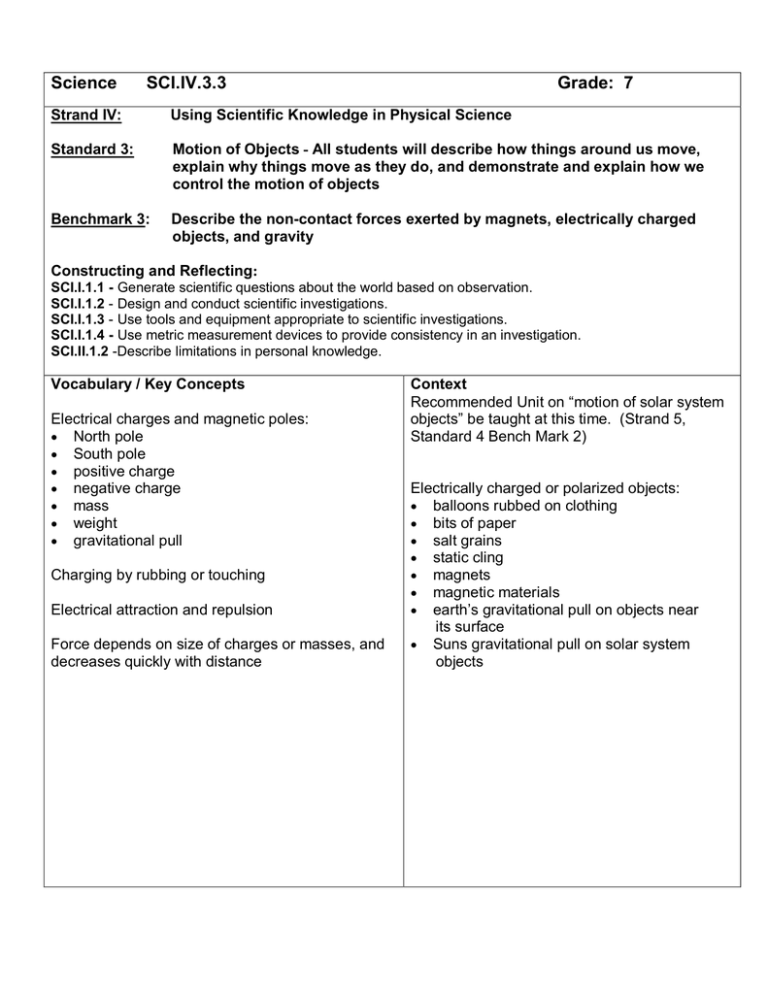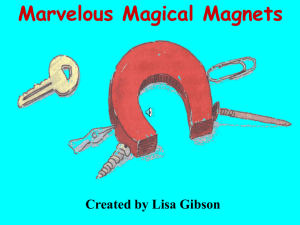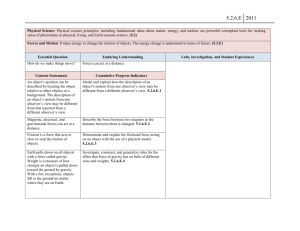Science SCI.IV.3.3 Grade: 7
advertisement

Science SCI.IV.3.3 Grade: 7 Strand IV: Using Scientific Knowledge in Physical Science Standard 3: Motion of Objects ­ All students will describe how things around us move, explain why things move as they do, and demonstrate and explain how we control the motion of objects Benchmark 3: Describe the non­contact forces exerted by magnets, electrically charged objects, and gravity Constructing and Reflecting: SCI.I.1.1 ­ Generate scientific questions about the world based on observation. SCI.I.1.2 ­ Design and conduct scientific investigations. SCI.I.1.3 ­ Use tools and equipment appropriate to scientific investigations. SCI.I.1.4 ­ Use metric measurement devices to provide consistency in an investigation. SCI.II.1.2 ­Describe limitations in personal knowledge. Vocabulary / Key Concepts Electrical charges and magnetic poles: · North pole · South pole · positive charge · negative charge · mass · weight · gravitational pull Charging by rubbing or touching Electrical attraction and repulsion Force depends on size of charges or masses, and decreases quickly with distance Context Recommended Unit on “motion of solar system objects” be taught at this time. (Strand 5, Standard 4 Bench Mark 2) Electrically charged or polarized objects: · balloons rubbed on clothing · bits of paper · salt grains · static cling · magnets · magnetic materials · earth’s gravitational pull on objects near its surface · Suns gravitational pull on solar system objects Knowledge and Skills Resources Coloma Resources: Students will describe forces exerted from a distance, with objects not touching, such as “May the Magnetic Force Be with You!” magnetic attraction, or repulsion, attraction or (attached) repulsion between electric charges, and Other Resources: gravitational attraction. These types of forces are called non­contact forces because they occur · Teachers’ Domain – Electricity and between objects that don’t touch. These forces can Magnetism – video clips, interactives, be demonstrated by the following: images and documents. Awesome!! (1 st link­ free sign­up, 2 nd link info) Magnets unlike poles attract (north pole to south pole). Like poles repel (north pole to north pole). · SMILE – IL Institute of Tech – Electricity and Magnetism links – 35+ single concept Electrically charged objects like charges repel lessons vetted and posted by teachers. (positive to positive), unlike charges attract (positive Excellent! to negative). · ThinkQuest – Phocus on Physics – Gravity is an attractive force that occurs between outstanding site dedicated to teaching any two objects that have mass. These objects are physics. Fun! attracted to each other (moon held in orbit by the earth). The greater the mass the larger the · The Exploratorium – Science Snacks about gravitational pull. Electricity – lots of excellent and easy activities to illustrate concepts. · The Exploratorium – Science Snacks about Magnetism – lots of excellent and easy activities to illustrate concepts. · Physical Science Activity Manual –book written by a group of teachers using the learning cycle and 34 activities to teach physical science. Excellent resource! · ExploreLearning – Motion and Force – excellent site – free preview, but requires subscription. · Michigan Teacher Network Resources · AIMS activities Floating Magnets and Tug of War activities from “Mostly Magnets” copyright 1991. AIMS Foundation · TOPS: “Magnetism” · Bill Nye: Gravity, Friction, Magnetism · Science Explosion Resources Continued Videoconferences Available For more information, see www.remc11.k12.mi.us/dl or call Janine Lim 471­7725x101 or email jlim@remc11.k12.mi.us IV.3.MS.3 Describe the non­contract forces exerted by magnets, electrically charged objects, and gravity Magnets to Motors from Adventure Science Center Galileo's Workshop from Cranbrook Institute of Science Magnetism from COSI Toledo Magnet Mania from Discovery Center of Springfield Caution: Falling EVERYTHING! (Microgravity Expedition) from NASA Johnson Space Center Magnetism: A Strong Attraction from National Science Center 7 th Grade Science Curriculum Technology Resources IV.3.MS.3 Vernier probes available: Force Sensor, Magnetic Field Sensor Instruction Focus Question: How do magnets interact? Assessment Optional Assessment Give the students several ring magnets, and a pencil. Ask students, “Between two magnets which is Ask the students, “What would happen if a student stronger the push or the pull?” Discuss possible put two ring magnets on an upright pencil?” answers and reasons for answers. Give each group two similar magnets (any kinds) and a ruler. Have students make predictions. Perform the simple investigation. Explain that the students are going to measure how Then let the students arrange various numbers of close one magnet must be to another before the magnets in various ways, and draw what they other one moves (any movement counts). observe. Have the students measure the spaces between the 1.) Place a ruler flat on a desk. magnets and see how they change. 2.) Place one magnet at the end of the ruler (0 cm). 3.) Place and slide a second magnet from the opposite end of the ruler until the first magnet moves (attracted or repelled). 4.) Repeat using different magnetic end combinations. N to N, N to S, S to S, S to N. Students will record their data and write their conclusions. Each group will present its data and the teacher will construct a graph of class data. Students should conclude that the movement will occur at the same distance no matter what combination of poles is used. When like pole combinations are used, a push occurs, and when unlike pole combinations are used, a pull occurs. During the investigation, students are to provide a written response to the following questions based upon their observations: · What patterns do you see in the behavior of the magnets and the spaces between them? · What would happen if the pencil was not there? · Why does the magnet float on one side and not the other side? · What happens to the spaces between the magnets as magnets are added? · How can you make the top magnet jump off the pencil? · What can you infer about magnets from this investigation? (Give students rubric before activity.) Scoring Rubric Criteria: Correctness of answers – Apprentice Answers fewer than two questions with some correct information. Basic ­ Answers two to three questions correctly. Meets ­ Answers all four questions correctly without contradictions. Exceeds ­ Answers the four questions with complete responses and clear, coherent, unambiguous, and elegant explanations. Criteria: Accuracy of inference – Apprentice ­ Writes an inference with numerous inconsistencies and few consistencies. Basic ­ Writes an inference that contains some consistencies. Meets ­ Writes a complete and accurate inference. Exceeds ­ Writes a complete and accurate inference based on past experimentation. Teacher Notes: · The force that magnets exert on certain metals and each other is an invisible force that acts “at a distance” without coming into contact with the object it moves. Electric charges can also exert non­ contact forces, following the same rules as magnets (like charges repel, unlike charges attract). · Gravity is also a non­contact force. However, it is only an attractive force. Non­contact forces weaken quickly as the distance between the objects increases. (JCISD) Focus Question · What are the non­contact forces affected by magnets, static electricity and gravity?



